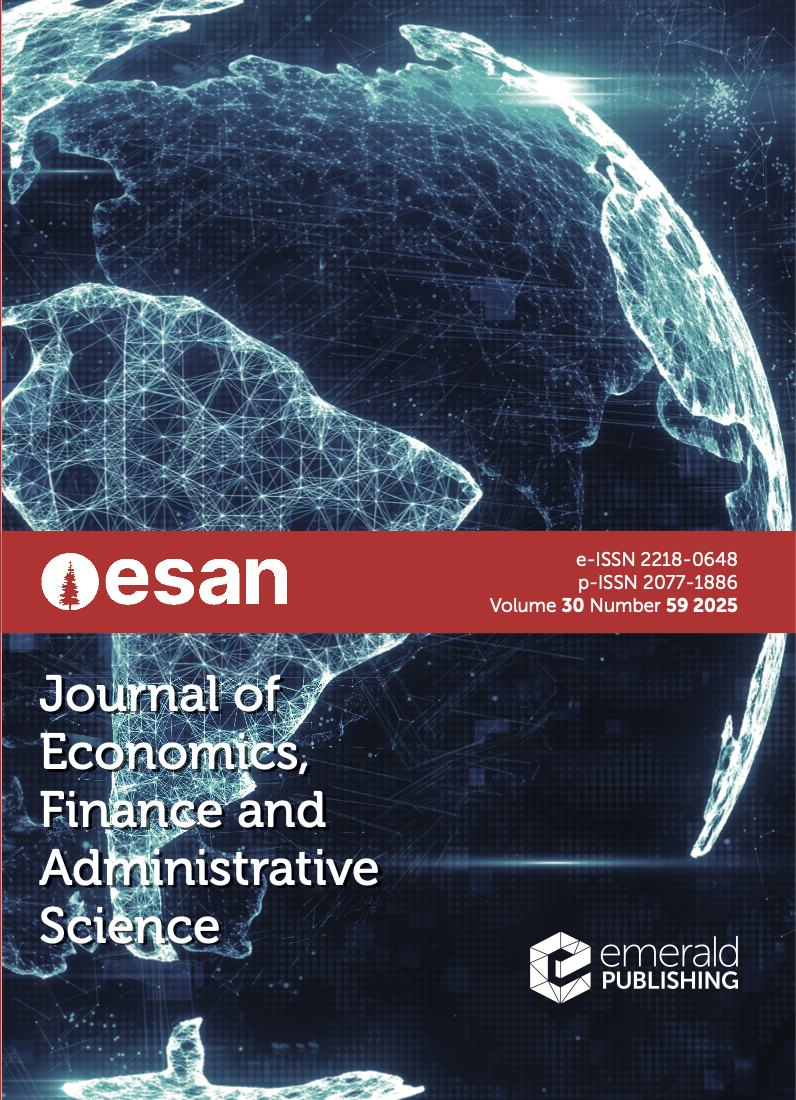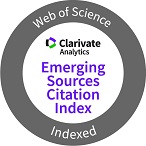Exploring the asymmetric relationship between macroeconomic factors and corporate profitability in the MSCI Colombia index
Keywords:
Asymmetry, DLNM, Factor analysis, MSCI index, ProfitabilityAbstract
PurposeThis study aims to explore the asymmetric effects of macroeconomic factors on the profitability of large-cap companies in an emerging country like Colombia, using the Morgan Stanley Capital International (MSCI) Colombia index as the basis.
Design/methodology/approachWe employ a combination of singular spectrum analysis (SSA) and principal component analysis (PCA) to identify and estimate four key macroeconomic factors that account for approximately 47.8% of Colombia's macroeconomy. These factors encompass indicators related to inflation and cost of living, foreign trade and exchange rate, employment and labor force and trade and production in Colombia. We utilize the distributed lag nonlinear model (DLNM) to analyze the asymmetric relationships between these factors and corporate profitability, considering different scenarios and lags.
FindingsOur analysis reveals that there are indeed asymmetric relationships between the identified macroeconomic factors and corporate profitability. These relationships exhibit variability over time and lags, indicating the nuanced nature of their impact on corporate performance.
Originality/valueThis study contributes to the existing literature by applying a novel methodology that combines SSA and PCA to identify macroeconomic factors within the Colombian context. Additionally, our focus on asymmetric relationships and their dynamic nature in relation to corporate profitability, using DLNM, adds original insights to the research on this subject.
Downloads
References
Abugri, B.A. (2008), “Empirical relationship between macroeconomic volatility and stock returns: evidence from Latin American markets”, International Review of Financial Analysis, Vol. 17 No. 2, pp. 396-410, doi: 10.1016/j.irfa.2006.09.002.
Acevedo Prins, N.M., Jiménez Gómez, L.M. and Castaño, N.E. (2017), “Relación de causalidad de variables macroeconómicas locales y globales sobre el índice COLCAP”, Espacios, Vol. 38 No. 21, pp. 1-10.
Agudelo, D.A. and Gutierrez, A. (2011), “Anuncios macroeconómicos y mercados accionarios: el caso latinoamericano”, Academia. Revista Latinoamericana de Administración, Vol. 48, pp. 1-20.
Amengual, D. and Watson, M.W. (2007), “Consistent estimation of the number of dynamic factors in a large N and T panel”, Journal of Business and Economic Statistics, Vol. 25 No. 1, pp. 91-108, doi: 10.1198/073500106000000585.
Bai, J. and Ng, S. (2002), “Determining the number of factors in approximate factor models”, Econometrica, Vol. 70 No. 1, pp. 191-221, doi: 10.1111/1468-0262.00273.
Bai, J. and Ng, S. (2021), “Matrix completion, counterfactuals, and factor analysis of missing data”, Journal of the American Statistical Association, Vol. 116 No. 536, pp. 1841-1855, doi: 10.1080/01621459.2021.1967163.
Bernanke, B.S., Boivin, J. and Eliasz, P. (2005), “Measuring the effects of monetary policy: a factor-augmented vector autoregressive (FAVAR) approach”, Quarterly Journal of Economics, Vol. 120 No. 1, pp. 387-422, doi: 10.1162/0033553053327452.
Bógalo, J., Poncela, P. and Senra, E. (2021), “Circulant singular spectrum analysis to monitor the state of the economy in real time”, Mathematics, Vol. 9 No. 11, 1169, doi: 10.3390/math9111169.
Cardona, L., Gutiérrez, M. and Agudelo, D.A. (2017), “Volatility transmission between US and Latin American stock markets: testing the decoupling hypothesis”, Research in International Business and Finance, Vol. 39, pp. 115-127, doi: 10.1016/j.ribaf.2016.07.008.
Chakrabarti, R., Huang, W., Jayaraman, N. and Lee, J. (2005), “Price and volume effects of changes in MSCI indices - nature and causes”, Journal of Banking and Finance, Vol. 29 No. 5, pp. 1237-1264, doi: 10.1016/j.jbankfin.2004.04.002.
Chen, N.-F., Roll, R. and Ross, S.A. (1986), “Economic forces and the stock market”, The Journal of Business, Vol. 59 No. 3, pp. 383-403, doi: 10.1086/296344.
Coussin, M. (2022), “Singular spectrum analysis for real-time financial cycles measurement”, Journal of International Money and Finance, Vol. 120, 102532, doi: 10.1016/j.jimonfin.2021.102532.
de Carvalho, M. and Rua, A. (2017), “Real-time nowcasting the US output gap: singular spectrum analysis at work”, International Journal of Forecasting, Vol. 33 No. 1, pp. 185-198, doi: 10.1016/j.ijforecast.2015.09.004.
de Carvalho, M., Rodrigues, P.C. and Rua, A. (2012), “Tracking the US business cycle with a singular spectrum analysis”, Economics Letters, Vol. 114 No. 1, pp. 32-35, doi: 10.1016/j.econlet.2011.09.007.
Gasparrini, A. (2011), “Distributed lag linear and non-linear models in R: the package dlnm”, Journal of Statistical Software, Vol. 43 No. 8, pp. 1-20, doi: 10.18637/jss.v043.i08.
Gasparrini, A. and Armstrong, B. (2013), “Reducing and meta-analysing estimates from distributed lag non-linear models”, BMC Medical Research Methodology, Vol. 13 No. 1, p. 1, doi: 10.1186/1471-2288-13-1.
Gronlund, C.J., Zanobetti, A., Schwartz, J.D., Wellenius, G.A. and O'Neill, M.S. (2014), “Heat, heat waves, and hospital admissions among the elderly in the United States, 1992-2006”, Environmental Health Perspectives, Vol. 122 No. 11, pp. 1187-1192, doi: 10.1289/ehp.1206132.
Guo, Y., Barnett, A.G., Pan, X., Yu, W. and Tong, S. (2011), “The impact of temperature on mortality in Tianjin, China: a case-crossover design with a distributed lag nonlinear model”, Environmental Health Perspectives, Vol. 119 No. 12, pp. 1719-1725, doi: 10.1289/ehp.1103598.
Guo, Y., Gasparrini, A., Armstrong, B., Li, S., Tawatsupa, B., Tobias, A., Lavigne, E., De Sousa Zanotti Stagliorio Coelho, M., Leone, M., Pan, X., Tong, S., Tian, L., Kim, H., Hashizume, M., Honda, Y., Guo, Y.L.L., Wu, C.F., Punnasiri, K., Yi, S.M., Williams, G. and Saldiva, P.H.N. (2014), “Global variation in the effects of ambient temperature on mortality: a systematic evaluation”, Epidemiology, Vol. 25 No. 6, pp. 781-789, doi: 10.1097/EDE.0000000000000165.
Hallin, M. and Liška, R. (2007), “Determining the number of factors in the general dynamic factor model”, Journal of the American Statistical Association, Vol. 102 No. 478, pp. 603-617, doi: 10.1198/016214506000001275.
Hamao, Y. (1988), “An empirical examination of the Arbitrage Pricing Theory. Using Japanese data”, Japan and the World Economy, Vol. 1 No. 1, pp. 45-61, doi: 10.1016/0922-1425(88)90005-9.
Hassani, H. and Thomakos, D. (2010), “A review on singular spectrum analysis for economic and financial time series”, Statistics and Its Interface, Vol. 3 No. 3, pp. 377-397, doi: 10.4310/sii.2010.v3.n3.a11.
Hassani, H., Rua, A., Silva, E.S. and Thomakos, D. (2019), “Monthly forecasting of GDP with mixed-frequency multivariate singular spectrum analysis”, International Journal of Forecasting, Vol. 35 No. 4, pp. 1361-1372, doi: 10.1016/j.ijforecast.2019.03.021.
Islam, A.R.M.T., Hasanuzzaman, M., Azad, M.A.K., Salam, R., Toshi, F.Z., Khan, M.S.I., Alam, G.M.M. and Ibrahim, S.M. (2021), “Effect of meteorological factors on COVID-19 cases in Bangladesh”, Environment, Development and Sustainability, Vol. 23 No. 6, pp. 8159-8178, doi: 10.1007/s10668-020-01016-1.
Joaqui-Barandica, O., Manotas-Duque, D.F. and Uribe, J.M. (2022), “Commonality, macroeconomic factors and banking profitability”, The North American Journal of Economics and Finance, Vol. 62, 101714, doi: 10.1016/j.najef.2022.101714.
Josse, J. and Husson, F. (2012), “Handling missing values in exploratory multivariate data analysis methods”, Journal de la Société Française de Statistique, Vol. 153 No. 2, pp. 79-99.
Konchitchki, Y., Luo, Y., Ma, M.L.Z. and Wu, F. (2016), “Accounting-based downside risk, cost of capital, and the macroeconomy”, Review of Accounting Studies, Vol. 21 No. 1, pp. 349-392, doi: 10.1007/s11142-015-9338-7.
Kruel, M. and Ceretta, P.S. (2022), “Asymmetric influences on Latin American stock markets: a quantile approach”, The Journal of Economic Asymmetries, Vol. 26, e00262, doi: 10.1016/j.jeca.2022.e00262.
Kyaw, N.N.A., Los, C.A. and Zong, S. (2006), “Persistence characteristics of Latin American financial markets”, Journal of Multinational Financial Management, Vol. 16 No. 3, pp. 207-218, doi: 10.1016/j.mulfin.2005.08.001.
Lebart, L., Morineau, A. and Piron, M. (1995), Statistique Exploratoire Multidimensionnelle, 3rd ed., Dunod, Paris.
McCracken, M.W. and Ng, S. (2021), “FRED-QD: a quarterly database for macroeconomic research”, Federal Reserve Bank of St. Louis Review, Vol. 103 No. 1, pp. 1-44, doi: 10.20955/r.103.1-44.
Onatski, A. (2010), “Determining the number of factors from empirical distribution of eigenvalues”, The Review of Economics and Statistics, Vol. 92 No. 4, pp. 1004-1016, doi: 10.1162/REST_a_00043.
Oviedo Gómez, A.F. and Sierra Suárez, L.P. (2019), “Importancia de los términos de intercambio en la economía colombiana”, Revista de la CEPAL, Vol. 2019 No. 128, pp. 49-64, doi: 10.18356/73298cb5-es.
Poon, S. and Taylor, S.J. (1991), “Macroeconomic factors and the UK stock market”, Journal of Business Finance and Accounting, Vol. 18 No. 5, pp. 619-636, doi: 10.1111/j.1468-5957.1991.tb00229.x.
Rapach, D.E., Wohar, M.E. and Rangvid, J. (2005), “Macro variables and international stock return predictability”, International Journal of Forecasting, Vol. 21 No. 1, pp. 137-166, doi: 10.1016/j.ijforecast.2004.05.004.
Rodrigues, P.C., Pimentel, J., Messala, P. and Kazemi, M. (2020), “The decomposition and forecasting of mutual investment funds using singular spectrum analysis”, Entropy, Vol. 22 No. 1, p. 83, doi: 10.3390/e22010083.
Sermpinis, G., Hassanniakalager, A., Stasinakis, C. and Psaradellis, I. (2021), “Technical analysis profitability and Persistence: a discrete false discovery approach on MSCI indices”, Journal of International Financial Markets, Institutions and Money, Vol. 73, 101353, doi: 10.1016/j.intfin.2021.101353.
Sirucek, M. (2012), “Macroeconomic variables and stock market: US review”, IJCSMS International Journal of Computer Science and Management Studies, Vol. 12 No. 2, pp. 22-31.
Stock, J.H. and Watson, M.W. (1996), “Evidence on structural instability in macroeconomic time series relations”, Journal of Business and Economic Statistics, Vol. 14 No. 1, pp. 11-30, doi: 10.1080/07350015.1996.10524626.
Stock, J.H. and Watson, M.W. (2002), “Forecasting using principal components from a large number of predictors”, Journal of the American Statistical Association, Vol. 97 No. 460, pp. 1167-1179, doi: 10.1198/016214502388618960.
Stock, J.H. and Watson, M.W. (2016), “Dynamic factor models, factor-augmented vector autoregressions, and structural vector autoregressions in macroeconomics”, in Handbook of Macroeconomics, Elsevier, Amsterdam, pp. 415-525, doi: 10.1016/bs.hesmac.2016.04.002.
Vlamis, P. (2007), “Default risk of the UK real estate companies: is there a macro-economy effect?”, The Journal of Economic Asymmetries, Vol. 4 No. 2, pp. 75-88, doi: 10.1016/j.jeca.2007.02.007.
Zamprogno, B., Reisen, V.A., Bondon, P., Aranda Cotta, H.H. and Reis, N.C. (2020), “Principal component analysis with autocorrelated data”, Journal of Statistical Computation and Simulation, Vol. 90 No. 12, pp. 2161-2181, doi: 10.1080/00949655.2020.1764556











